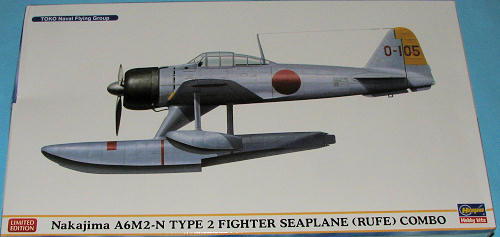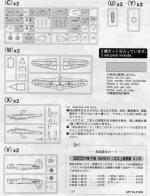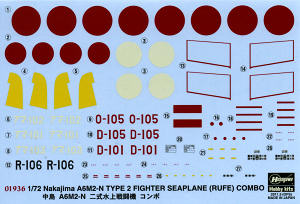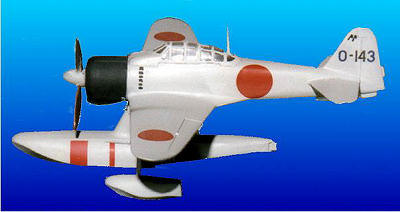
Hasegawa 1/72 A6M2-N 'Rufe' Combo
| KIT #: | 01936 |
| PRICE: | $35.95 from www.greatmodels.com (44.99 SRP) |
| DECALS: | Seven Options |
| REVIEWER: | Scott Van Aken |
| NOTES: | Two complete kits |

| HISTORY |
The aircraft was deployed in 1942, referred to as the "Suisen 2" ("Hydro fighter type 2"), and was only utilized in defensive actions in the Aleutians and Solomon Islands operations. Such seaplanes were effective in harassing American PT boats at night, and they were very difficult to detect, even with primitive radar. Close misses killed officers and crews of boats such as PT 105. They could also drop flares to illuminate the PTs which were vulnerable to destroyer gunfire, and depended on cover of darkness. Since the boats left a phosphorescent wake which was visible from the air, they would leave their engines in idle to minimize this. It was primarily for this reason that John F. Kennedy's PT 109 was caught off guard in idle and rammed by the destroyer Amagiri, unable to maneuver out of the way in time.
The seaplane also served as an interceptor for protecting fueling depots in Balikpapan and Avon Bases (Dutch East Indies) and reinforced the Shumushu base (North Kuriles) in the same period. Such fighters served aboard seaplane carriers Kamikawa Maru in the Solomons and Kuriles areas and aboard Japanese raiders Hokoku Maru and Aikoku Maru in Indian Ocean raids. In the Aleutian Campaign this fighter engaged with Lockheed P-38 Lightning fighters and Boeing B-17 Flying Fortress bombers. The aircraft was used for interceptor, fighter-bomber, and short reconnaissance support for amphibious landings, among other uses.
Later in the conflict the Otsu Air Group utilized the A6M2-N as an interceptor alongside Kawanishi N1K1 Kyofu ("Rex") aircraft based in Biwa lake in the Honshū area.
The last A6M2-N in military service was a single example recovered by the French forces in Indochina after the end of World War II. It crashed shortly after being overhauled.
The large float and wing pontoons of the A6M2-N degraded its performance by about 20%, enough that the A6M2-N was not usually a match for even the first generation of Allied fighters. All A6M2-Ns were built by Nakajima.
| THE KIT |
 This
is not a new mold kit, having been released about the same time that Hasegawa
produced their other series of A6M Zero fighters. However, it has been a popular
seller over the years and so it was not a surprise to see it come in one of
Hasegawa's double kits. I guess that this is the latest marketing tool for
Hasegawa as I have seen a number of these types of boxings from them in the last
few years. One would think that doubling things up would make for a savings in
terms of each kit, but I have not seen that happening. One just gets two
standard kits in the same box.
This
is not a new mold kit, having been released about the same time that Hasegawa
produced their other series of A6M Zero fighters. However, it has been a popular
seller over the years and so it was not a surprise to see it come in one of
Hasegawa's double kits. I guess that this is the latest marketing tool for
Hasegawa as I have seen a number of these types of boxings from them in the last
few years. One would think that doubling things up would make for a savings in
terms of each kit, but I have not seen that happening. One just gets two
standard kits in the same box.
The molds for these planes have held up well over the years. They are still crisply done and show no real flash or sink areas. Of the four grey sprues, one is a generic Zero sprue so there will be pieces you will not be using (like the landing gear). The other three sprues are strictly for the Rufe with a new fuselage, floats and wing assembly. The kit also includes a beaching dolly. You do need to put some weight in the front of the main float to keep the model from leaning back and there is a separate rear float stand.
Typical of all of Hasegawa's 1/72 kits, this one relies on decals for the instrument panel. There are no belts included but you can make lap belts out of tape. The interior is quite simple with a seat, floor and control stick. The prop blades are separate items and while I do not particularly like this arrangement, it works well for this kit. A complete, though somewhat generic two row radial is provided. Most of it will be hidden in the cowling behind the large spinner. This is all topped with a one-piece canopy section.
 There
are three markings options. One is the box art plane of the Toko Naval FG. Code: 0-105
Aleutian Islands Kiska Island Summer 1942 with a yellow rudder and the light
greyish camouflage. Two other tail code options are provided for this aircraft. Second is a similar plane of the 5th FG. Code: R-106
Aleutian Islands Kiska Island 1942. The third option is a green over grey
version of the AMAKUSA Naval FG. May 1945. This aircraft also has two other tail
code options, with all options for this one being in white.
There
are three markings options. One is the box art plane of the Toko Naval FG. Code: 0-105
Aleutian Islands Kiska Island Summer 1942 with a yellow rudder and the light
greyish camouflage. Two other tail code options are provided for this aircraft. Second is a similar plane of the 5th FG. Code: R-106
Aleutian Islands Kiska Island 1942. The third option is a green over grey
version of the AMAKUSA Naval FG. May 1945. This aircraft also has two other tail
code options, with all options for this one being in white.
The 'grey' planes have a rather odd color mixture required according to the painting scheme. You take 90% Mitsubishi dark green and add 10% purple. Frankly, I think there is some sort of glitch as it would be more logical to use light grey vice dark green and besides, historians have poo-poo'd the purple Rufe deal for many years. Decals are nicely printed and have a white that is more off-white than pure white.
| CONCLUSIONS |
 This is not the first 1/72 'Rufe' kit with Frog doing
a very simple version back in the 1970s. I would be surprised if that were the
only injected 1/72 'Rufe' around but it is the only other one that comes to
mind (I have been reminded that Jo-Han did one in one of their 'convertible'
kits, which I now recall having built). This same kit (Frog) was released in a Revell box after Revell purchased all the
Axis aircraft molds from Russia's Novo after they bought the Frog molds.
Here is an image of the Frog version built many years back.
This is not the first 1/72 'Rufe' kit with Frog doing
a very simple version back in the 1970s. I would be surprised if that were the
only injected 1/72 'Rufe' around but it is the only other one that comes to
mind (I have been reminded that Jo-Han did one in one of their 'convertible'
kits, which I now recall having built). This same kit (Frog) was released in a Revell box after Revell purchased all the
Axis aircraft molds from Russia's Novo after they bought the Frog molds.
Here is an image of the Frog version built many years back.
| REFERENCES |
Wikipedia
December 2011
You can get this kit and many others from
GreatModels
If you would like your product reviewed fairly and
fairly quickly , please
contact
me or see other details in the
Note to
Contributors.